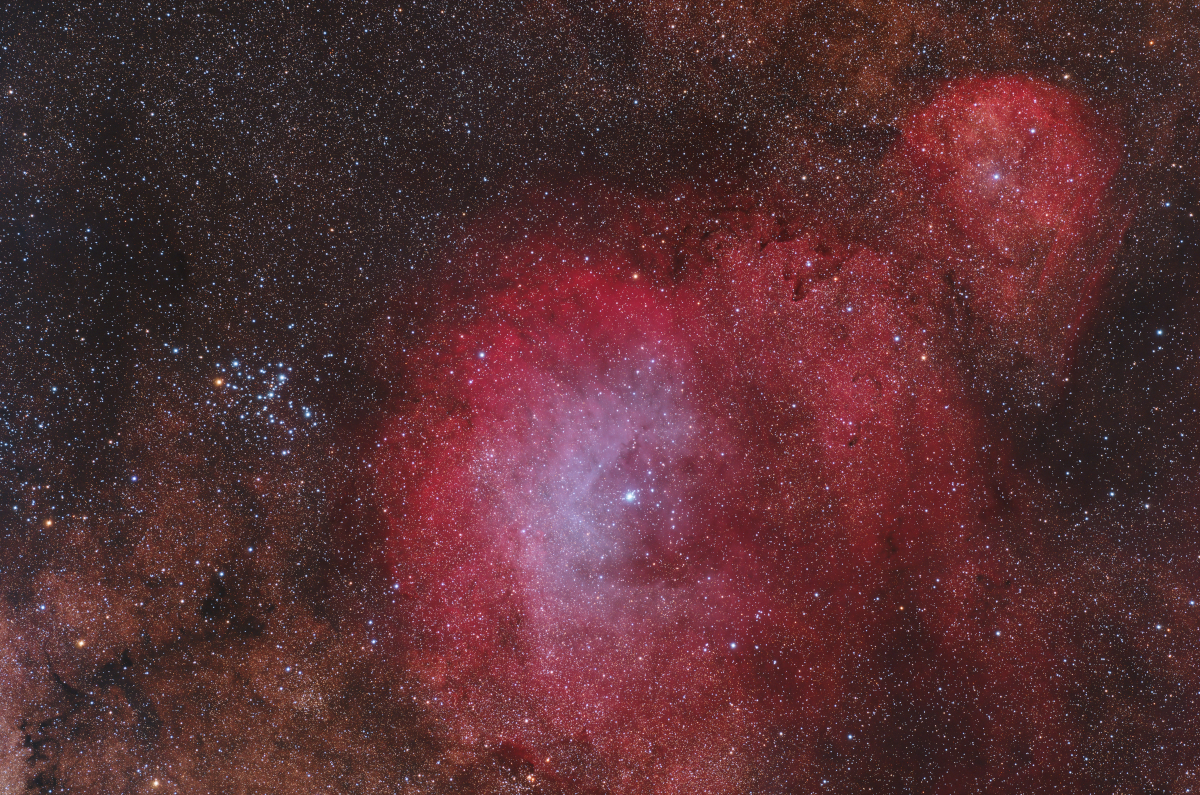
[back] M 6 (Butterfly Cluster) with RCW 133 and NGC 6383 in Scorpius[NED]

|
0.5 degree |
|
(c) 2023 All astro photo images are copyrighted. They may not be used or reproduced without explicit written permission from the authors.
About this Image / Über dieses Bild
| Camera: | Moravian C3-PRO-61000 Mono CMOS |
| Image Type, Orientation: | R+Ha,G+OIII,B+OIII Composite, North is at 12:00 |
| Exposure time: | R,G,B: 20x120 sec., Ha: 23x300 sec., OIII: 13x300 sec. (5h total), unguided |
| Exposure date: | June 9th..13th, 2023 |
| Location: | Capella Observatory South at Kiripotib Astro Farm, Namibia, remote-controlled from Heroldsbach/Germany |
| Filter: | Astronomik Deep-Sky RGB Filter set and 6nm Ha, 6nm OIII on Moravian EFW-3L-9-II External Filter Wheel |
| Instrument: | "Callisto", a Takahashi FSQ 106N, 530mm focal length, 106mm aperture, f/5 on modified Losmandy G11 (high res encoders with OnStepX) |
| Photographer: | Rainer Raupach, Josef Pöpsel, Frank Sackenheim |
| Remarks: |
The open star cluster Messier 6 (slightly left to the
image center), also known as the Butterfly Cluster, in the constellation
Scorpius, is the Messier object closest to the apparent center of the Milky
Way. Approximately 120 stars up to an apparent brightness of 15 magnitudes
are associated with this cluster. Most of these stars belong to the spectral
class B and appear blue, but the brightest member is an orange K-type giant
star (BM Scorpii), creating a beautiful color contrast with the other stars.
The cluster has an absolute diameter of about 12 light-years at a distance
of approximately 1600 light-years. Therefore, M6 appears to cover an area
roughly equivalent to the size of the full moon. In the apparent vicinity, the young open star cluster NGC 6383 can be found, which is nearly twice as far away (2900 light-years). The cluster was described by its discoverer, John Herschel, as unusual because a fifth-magnitude O-type star clearly stands out while the rest of the stars are considerably fainter. NGC 6383 is surrounded by an emission nebula (Ha and OIII added by narrow band data). Additionally, in the upper right corner of the image, the HII region RCW 133 can be seen. BlurrXTerminator was used for the image (option "correct only") |
|
|
|
| Bemerkungen: |
Der offene Sternhaufen Messier 6
(im Bild etwas links der Mitte) im Sternbild Skorpion, auch
Schmetterlingshaufen genannt, ist das dem (scheinbaren) Zentrum der
Milchstraße am nächsten gelegene Messier-Objekt. Etwa 120 Sterne bis zur
scheinbaren Helligkeit 15 mag werden dem Haufen zugeordnet. Davon gehören
die meisten hellen der Spektralklasse B an und erscheinen blau, das
allerhellste Mitglied aber ist ein oranger K-Riesenstern (BM Scorpii), der
damit einen schönen Farbkontrast zu den anderen auffälligen Sternen erzeugt.
Der absolute Durchmesser beträgt etwa 12 Lichtjahre bei einer Entfernung von
ca. 1600 Lichtjahren. Damit nimmt M 6 scheinbar ungefähr die Fläche des
Vollmonds am Himmel ein.
Das Bild wurde mit dem BlurrXTerminator bearbeitet, wobei lediglich "correct only" verwendet wurde. |
Back to the Open Clusters Overview / Zurück zur Offene-Sternhaufen-Übersichtsseite